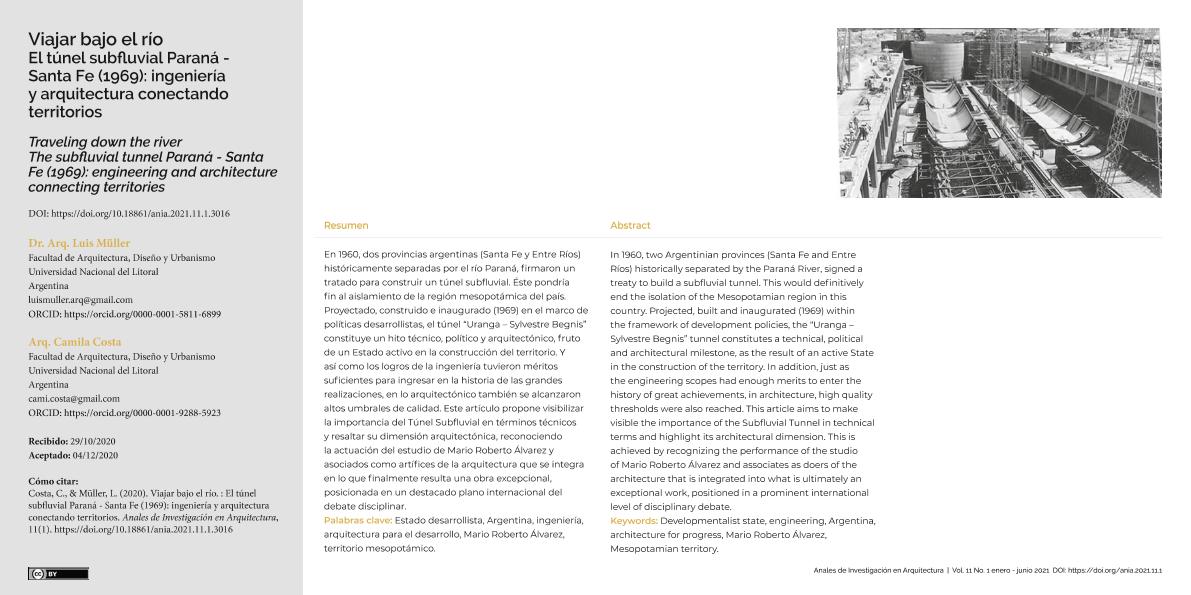Mostrar el registro sencillo del ítem
dc.contributor.author
Müller, Luis
dc.contributor.author
Costa, Camila

dc.date.available
2022-09-05T14:41:20Z
dc.date.issued
2021-01
dc.identifier.citation
Müller, Luis; Costa, Camila; Viajar bajo el río. El túnel subfluvial Paraná-Santa Fe (1969): ingeniería y arquitectura conectando territorios; Universidad ORT; Anales de Investigación en Arquitectura; 11; 1; 1-2021; 4-14
dc.identifier.issn
2301-1505
dc.identifier.uri
http://hdl.handle.net/11336/167345
dc.description.abstract
En 1960, dos provincias argentinas (Santa Fe y Entre Ríos) históricamente separadas por el río Paraná, firmaron un tratado para construir un túnel subfluvial. Éste pondría fin al aislamiento de la región mesopotámica del país. Proyectado, construido e inaugurado (1969) en el marco de políticas desarrollistas, el túnel “Uranga – Sylvestre Begnis” constituye un hito técnico, político y arquitectónico, fruto de un Estado activo en la construcción del territorio. Y así como los logros de la ingeniería tuvieron méritos suficientes para ingresar en la historia de las grandes realizaciones, en lo arquitectónico también se alcanzaron altos umbrales de calidad. Este artículo propone visibilizar la importancia del Túnel Subfluvial en términos técnicos y resaltar su dimensión arquitectónica, reconociendo la actuación del estudio de Mario Roberto Álvarez y asociados como artífices de la arquitectura que se integra en lo que finalmente resulta una obra excepcional, posicionada en un destacado plano internacional del debate disciplinar.
dc.description.abstract
In 1960, two Argentinian provinces (Santa Fe and Entre Ríos) historically separated by the Paraná River, signed a treaty to build a subfluvial tunnel. This would definitively end the isolation of the Mesopotamian region in this country. Projected, built and inaugurated (1969) within the framework of development policies, the “Uranga – Sylvestre Begnis” tunnel constitutes a technical, political and architectural milestone, as the result of an active State in the construction of the territory. In addition, just as the engineering scopes had enough merits to enter the history of great achievements, in architecture, high quality thresholds were also reached. This article aims to make visible the importance of the Subfluvial Tunnel in technical terms and highlight its architectural dimension. This is achieved by recognizing the performance of the studio of Mario Roberto Álvarez and associates as doers of the architecture that is integrated into what is ultimately an exceptional work, positioned in a prominent international level of disciplinary debate.
dc.format
application/pdf
dc.language.iso
spa
dc.publisher
Universidad ORT
dc.rights
info:eu-repo/semantics/openAccess
dc.rights.uri
https://creativecommons.org/licenses/by/2.5/ar/
dc.subject
ESTADO DESARROLLISTA
dc.subject
ARGENTINA
dc.subject
INGENIERÍA
dc.subject
ARQUITECTURA PARA EL DESARROLLO
dc.subject.classification
Otras Humanidades

dc.subject.classification
Otras Humanidades

dc.subject.classification
HUMANIDADES

dc.title
Viajar bajo el río. El túnel subfluvial Paraná-Santa Fe (1969): ingeniería y arquitectura conectando territorios
dc.title
Traveling down the river. The subfluvial tunnel Paraná-Santa Fe (1969): engineering and architecture connecting territories
dc.type
info:eu-repo/semantics/article
dc.type
info:ar-repo/semantics/artículo
dc.type
info:eu-repo/semantics/publishedVersion
dc.date.updated
2022-08-30T20:08:15Z
dc.identifier.eissn
2301-1513
dc.journal.volume
11
dc.journal.number
1
dc.journal.pagination
4-14
dc.journal.pais
Uruguay

dc.journal.ciudad
Montevideo
dc.description.fil
Fil: Müller, Luis. Universidad Nacional del Litoral. Facultad de Arquitectura, Diseño y Urbanismo; Argentina
dc.description.fil
Fil: Costa, Camila. Consejo Nacional de Investigaciones Científicas y Técnicas. Centro Científico Tecnológico Conicet - Santa Fe; Argentina. Universidad Nacional del Litoral. Facultad de Arquitectura, Diseño y Urbanismo; Argentina
dc.journal.title
Anales de Investigación en Arquitectura
dc.relation.alternativeid
info:eu-repo/semantics/altIdentifier/url/https://revistas.ort.edu.uy/anales-de-investigacion-en-arquitectura/article/view/3016
dc.relation.alternativeid
info:eu-repo/semantics/altIdentifier/doi/http://dx.doi.org/10.18861/ania.2021.11.1.3016
Archivos asociados
